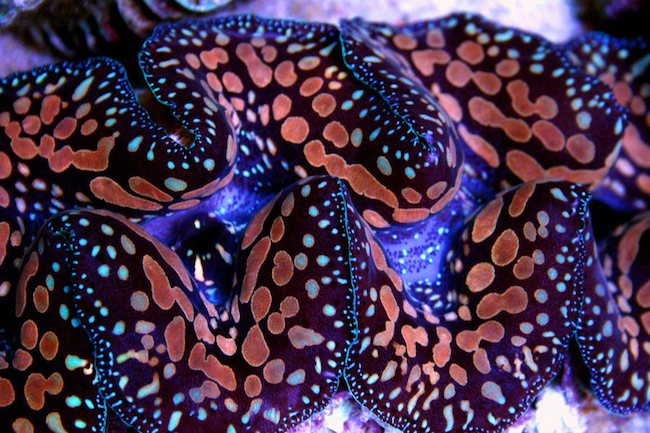It was quite amazing news to discover that the recognizable clams we’ve long called Teardrop Maximas are in fact a distinct species, Tridacna noae. Being ever the inquisitive aquarium journalists that we are, the notion of a new species of giant clam that is very similar to another species immediately made us wonder whether there exists hybrids of Tridacna noae and T. maxima.
While trawling our libraries of marine life images for pictures that illustrated the newly recognized teardrop maxima species, we only came across two images that seem to depict clams with an even mix of features from both Tridacna maxima and T. noae. If you’ll recall from our earlier overview the primary defining characteristics to differentiate maxima and teardrop clams is a row of neatly aligned eyespots in T. maxima and oval to circular markings that are rimmed in a lighter color for T. noae.
Both of the clams featured above and below show both of these features. A neatly aligned row of eyespots is clearly visible on the edge of the mantle, although these are not a neatly arranged as in a pure maxima clams. Also both clams show a degree of a white margin to their circular to oval spots, but again, they are much less distinct than a pure teardrop clam, in teh bivalve below you can even see the light colored margin in some areas of the mantle but not others.

There is some debate as to what species of giant clam can hybridize, or if it is even possible as follow up research on maxima and teardrop clams actually looked at precisely this. “The diameters of fertilized eggs of T. maxima, T. noae, and hybrids were 113.75 ± 18.5 ?m, 99.04 ± 8.1 ?m, and 116.3 ± 6.2 ?m, respectively. Although the hybrids developed successfully after fertilization, they died within two days. This crossbreeding experiment strongly suggests that T. noae is not an ecotype of T. maxima but a valid species.”
While a single spawning cross of two species may not yield juveniles in one experimental attempt, it’s also possible that certain environmental factors could lead to successful development. That or it simply is a very rare occurrence for wild hybridization to occur in the wild, and/or only a tiny fraction of hybrid specimens actually survive into adulthood.
So scientifically speaking, we are on “thin ice” when it comes to possibly labeling certain clam specimens as hybrids of two different species, and we’ll confess that we are probably the most guilty of this potentially erroneous labeling. However we can’t overlook that there’s certain cohorts of giant clams that are exported to the aquarium market, labeled as hybrid, which indeed do display characteristics of different species; there’s something there and it may not be hybrids, but it’s certainly worth looking into.
Big thanks once again to James Fatheree for discussing this issue with us and we look froward to learning and reporting further details on the notion of potential giant clam hybrids.



